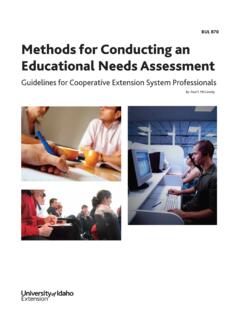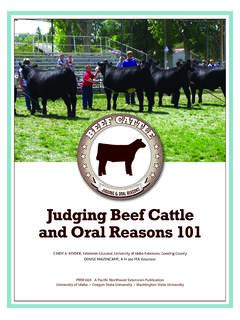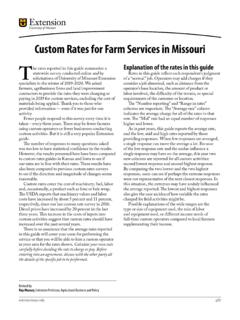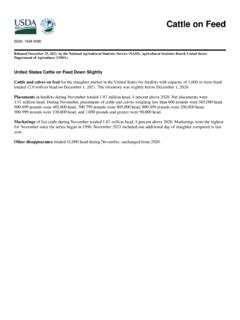Transcription of The Composting Process - uidaho.edu
1 DAIRY COMPOST PRODUCTION AND USE IN IDAHOCIS 1179 The Composting ProcessINTRODUCTIONWith a herd of 546,000 cows in 2009, Idaho dairies produce an million tons of raw dairy manure (feces and urine) each year. One ofthe greatest expenses associated with raw manure disposal is the cost oftransporting it from dairies to sites where it will be applied as typically reduces manure volume by 30 to 50%, which makesthe material significantly more affordable to transport and provides manyother benefits. While many people have a basic understanding of the Composting Process ,few people understand its complexity. Yet the better people understand thecomposting Process , the better the decisions they can make for effectiveand efficient Composting .
2 This publication explains what Composting is,how it happens, and how it is affected by various factors. WHAT IS COMPOST AND WHAT IS Composting ?Compost is the product of the controlled biological decomposition oforganic materials. More specifically, compost is the stable, humus-likeproduct resulting from the biological decomposition of organic matterunder controlled conditions. Another commonly accepted compostdefinition is that of the National Organic Standards Board (see at left:NOSB compost definition). Human control of the biological decomposition Process is what differenti-ates Composting from the natural decomposition of organic matter. Organicmaterials are recycled regardless of whether or not we compost them,but regulating and optimizing conditions ensures a faster Process and thegeneration of a quality end product.
3 HOW DOES Composting HAPPEN?Degradation of organic wastes is a natural Process and begins almost assoon as the wastes are generated. Under natural conditions, earthworms,nematodes, and soil insects such as mites, sowbugs, springtails, ants, andbeetles do most of the initial breakdown of organic materials into smallerparticles, thus increasing their exposure to microbial degradation. Undercontrolled conditions, Composting operators break down large wasteparticles through grinding or chopping. by L. Chen, M. de Haro Marti, A. Moore, C. FalenCONTENTSINTRODUCTION ..p. 1 WHAT IS COMPOST AND WHAT IS Composting ? ..p. 1 HOW DOES Composting HAPPEN? ..p. 1 FACTORS INFLUENCING Composting ..p. 2 What is the nutritious microbial food ?
4 P. 3 What are the water requirements? ..p. 4 What are suitable pH levels? ..p. 4 What are suitable temperature levels? ..p. 4 What is the oxygen demand? ..p. 4 ADDITIONAL RESOURCES ..p. 5 DairyNATIONAL ORGANIC STANDARDS BOARD DEFINITION OF COMPOSTThe product of a managed Process through whichmicroorganisms break down plant and animalmaterials into more available forms suitable forapplication to the soil. Compost must be producedthrough a Process that combines plant and animalmaterials with an initial C: N ratio of between25:1 and 40:1. Producers using an in-vessel or staticaerated pile system must maintain the compostingmaterials at a temperature between 131 F and170 F for three days.
5 Producers using a windrowsystem must maintain the Composting materials ata temperature between 131 F and 170 F for 15days, during which time, the materials must beturned a minimum of five times. THE Composting Process 2 Once optimal physical conditions are established, microbescolonize the organic material and initiate the compostingprocess (figure 1). Many of the microbes involved in decom-position are present in the wastes themselves. Soil microbes(such as bacteria, actinomycetes, fungi, and protozoa) areintroduced when the wastes are mixed with soil or inoculatedwith finished (C) compounds present in the organic materials areused by microorganisms as an energy source, transformedinto carbon dioxide (CO2), and released into the environ-ment.
6 As C is lost from the compost pile, the compostbecomes more condensed and air spaces within the pilebecome smaller. The oxygen (O2 ) remaining in the pile isquickly consumed by the resident microorganisms andmust be replenished to prevent the system from becominganaerobic (without oxygen). The most easily decomposed substances such as sugars andstarch are oxidized first. Compounds resistant to degradationsuch as lignin and cellulose make up the bulk of the finishedcompost organisms, which function best at 75 to 105 F,initiate the Composting Process (figure 2). As microbialactivity increases soon after compost piles are formed,temperatures within piles of sufficient volume and densityalso increase.
7 Thermophilic microorganisms take over attemperatures above 105 F. The temperature in the compostpile typically increases rapidly to 130 to 150 F within 24 to72 hours of pile formation, and can stay there for severaldays to several weeks depending on feedstocks properties,pile size, and environmental conditions. This is called theactive phase of Composting during which decomposition isthe most rapid. It continues until the bulk of the nutrient-and energy-containing materials within the piles have beentransformed. Remaining materials continue to decomposebut at a much slower rate. As microbial activity decreases, sodoes pile temperature. This is the curing phase of the active, thermophilic, phase, temperatures are highenough to kill pathogens and weed seeds and to break downphytotoxic compounds (organic compounds toxic to plants).
8 During this phase, O2must be replenished through passiveor forced aeration or by turning the compost pile. Care mustbe taken that temperatures do not become too elevated(> 160 F), because even thermophilic microbial populationsare killed by excessive heat. Excessive heat can also be afire the active Composting phase subsides, temperaturesgradually decline to around 100 F. Mesophilic microorganismsrecolonize the pile, and the compost enters the curing rate of O2consumption during curing declines to thepoint where compost can be stockpiled without materials continue to decompose and areconverted to biologically stable humic substances themature or finished compost. Potentially toxic organic acidsand resistant compounds are also stabilized during long curing phase is needed if the compost is unfinished orimmature.
9 This can happen if the pile contained too little O2or either too little or too much moisture. Immature compostscan contain high levels of organic acids, high C:N (nitrogen)ratios, extreme pH values, or high salt contents, all of whichcan damage or kill plants if the compost is applied to the is no clearly defined time for curing. Common practicesin commercial Composting operations range from 1 to 4months. However compost piles can cure for as long as 6 to12 INFLUENCING THE COMPOSTINGPROCESSC omposting is a microbial-driven Process . Like other livingcreatures, microbes need the right environment to surviveand thrive. For successful Composting , microbes neednutritious food ; suitable moisture, pH, and temperature;and COMPOST organic mattermineralswatermicrobesRAW MATERIALS organic mattermineralswatermicrobeswaterheat Figure Composting Process .
10 (Adapted from Rynk, R. 1992. On-Farm Composting Handbook (NRAES-54). Cooperative Extension,Ithaca, )160140120100907050 ABCDA=mesophilic phaseB=themophilic phaseC=mesophilic phaseD=maturation phaseActive phaseCuring phaseTimeFigure changes in an average compost pile. (Source:Cooperband, L. 2002. The Art and Science of Composting . Center forIntegrated Systems, University of Wisconsin. [accessed November 6,2010])THE Composting Process 3 WHAT IS THE NUTRITIOUS MICROBIAL FOOD ?During Composting , microbes break down organic compoundsto obtain energy to carry on their life processes and acquirenutrients (N, phosphorous, potassium) to sustain theirpopulations. Of the many elements required for microbialdecomposition, C and N are the most critical.










